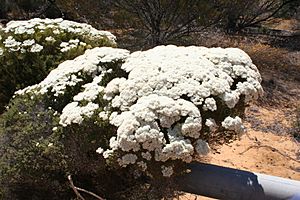Lambswool facts for kids
Quick facts for kids Wild cauliflower |
|
|---|---|
 |
|
| Scientific classification | |
| Genus: |
Verticordia
|
| Species: |
eriocephala
|
The Verticordia eriocephala, often called lambswool or wild cauliflower, is a beautiful flowering plant. It belongs to the myrtle family, called Myrtaceae. This plant grows only in the south-west part of Western Australia.
It's a shrub with many branches that spread out. It has small leaves and lots of creamy-white flowers that grow in dense groups. These flower clusters look a bit like lambswool or a cauliflower, which is how it got its common names! While it grows in many places, its numbers are slowly going down. This is mainly because land is being cleared for other uses and some people pick too many flowers from the wild.
Contents
What Does Wild Cauliflower Look Like?
The wild cauliflower is a shrub that can grow up to 2 m (7 ft) tall. It can also spread out from 0.15 m (0.5 ft) to 1.5 m (5 ft) wide. It has a single main stem that branches out a lot from its base.
Its leaves are shaped like an oval and are slightly cupped. They are about 3 mm (0.1 in) to 4 mm (0.2 in) long. Closer to the top, where the flowers grow, the leaves become shorter and wider.
The flowers have a nice smell and grow in thick, rounded clusters. Each flower sits on a tiny stalk, about 1.5 mm (0.06 in) long. The base of the flower, called the floral cup, is shaped like half a sphere and is hairy near the bottom.
The sepals, which are like small leaves that protect the flower bud, are creamy-white. They are about 2.0 mm (0.079 in) to 2.5 mm (0.098 in) long and have five hairy parts. They also have one or two thin hairs, called cilia, that stick out about 3.8 mm (0.1 in). The petals are white and almost round, about 1.5 mm (0.06 in) long, with a finely jagged edge. The style, which is part of the plant's reproductive system, is straight and smooth. It is about 3.5 mm (0.1 in) to 4.5 mm (0.2 in) long.
This plant flowers from September to January. It can even start flowering when it's only about 10 cm (4 in) tall!
The wild cauliflower's leaves are shorter and wider than those of a similar plant called Verticordia polytricha. You can also tell it apart from Verticordia capillaris by how hairy its flowers are. It also looks a bit like Verticordia brownii.
How the Wild Cauliflower Got Its Name
Scientists started collecting samples of this plant in the late 1800s. For many years, it was mistakenly identified as another plant, Verticordia brownii.
The wild cauliflower was officially described as Verticordia eriocephala in 1991 by a scientist named Alex George. He published his description in a science journal called Nuytsia. The plant samples he used were collected near Mount Adams, north of Eneabba.
Alex George explained that the second part of its scientific name, the specific epithet eriocephala, comes from two ancient Greek words: erion, meaning "wool," and cephala, meaning "head." This name describes how the flowering plant looks like large white, woolly heads.
Alex George grouped this species with other similar plants in a section called Corymbiformis. This group includes V. polytricha, V. densiflora, V. brownii, and V. capillaris.
Where Wild Cauliflower Grows
This plant grows in different types of soil, including yellow, grey, and white sands, and also on gravel. You can find it widely spread across sand hills and flat plains. Sometimes, it even grows in areas with granite rocks. It's often seen growing alongside other types of Verticordia plants.
Its range stretches across the south-west of Western Australia. It grows as far north as Mount Adams, as far east as Point Culver, and as far inland as Boorabbin National Park.
Protecting Wild Cauliflower
The Western Australian Government's Department of Parks and Wildlife says that Verticordia eriocephala is "not threatened." This means it's not currently in danger of disappearing. However, its numbers are going down because people are picking too many flowers from the wild plants.
Growing Wild Cauliflower at Home
The wild cauliflower is a very attractive shrub when its buds appear and when it's in full flower. Even when it's not flowering, its dense, bushy shape makes it a useful plant for gardens.
It's quite easy to grow new plants from cuttings (small pieces of the plant). However, it can sometimes be hard to find good pieces to take cuttings from, even from plants that are already growing in gardens. You can also grow new plants from its seeds.
Once established, these plants are strong and can handle frost. But be careful when pruning them! If you cut off the entire flowering head below the leaves, it can kill the plant.

